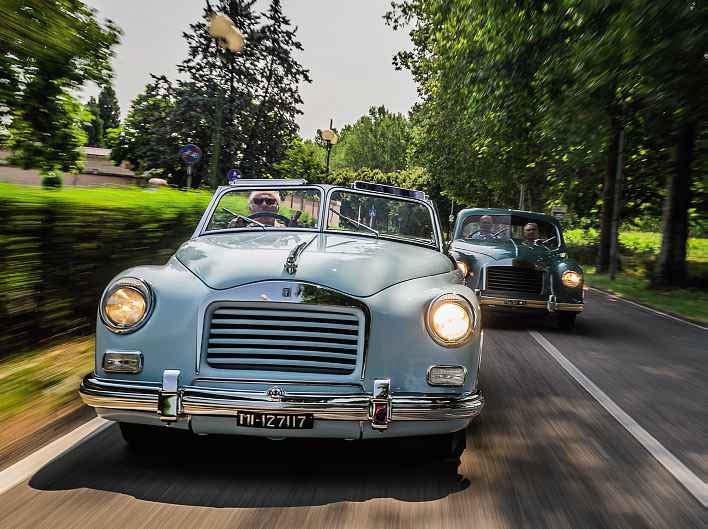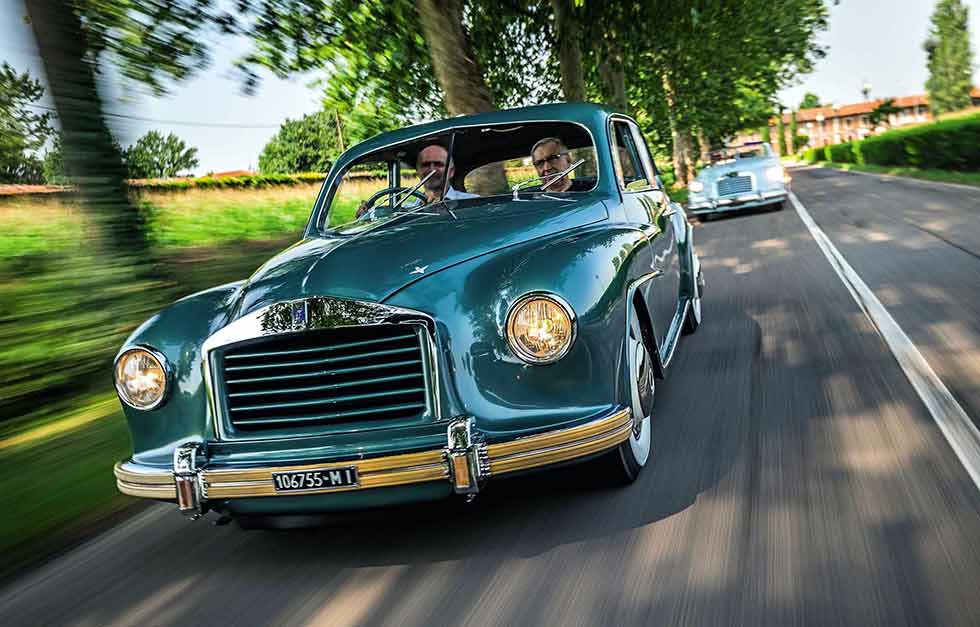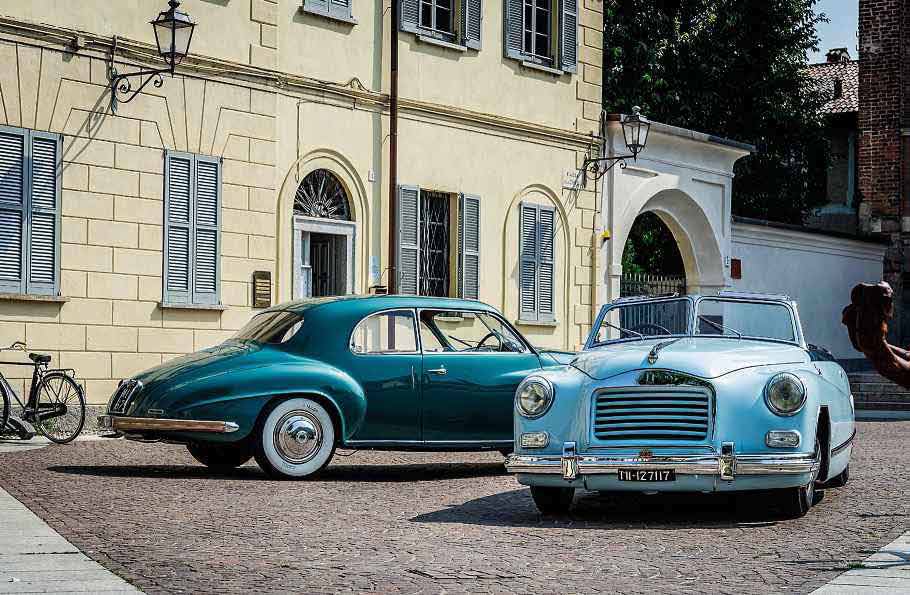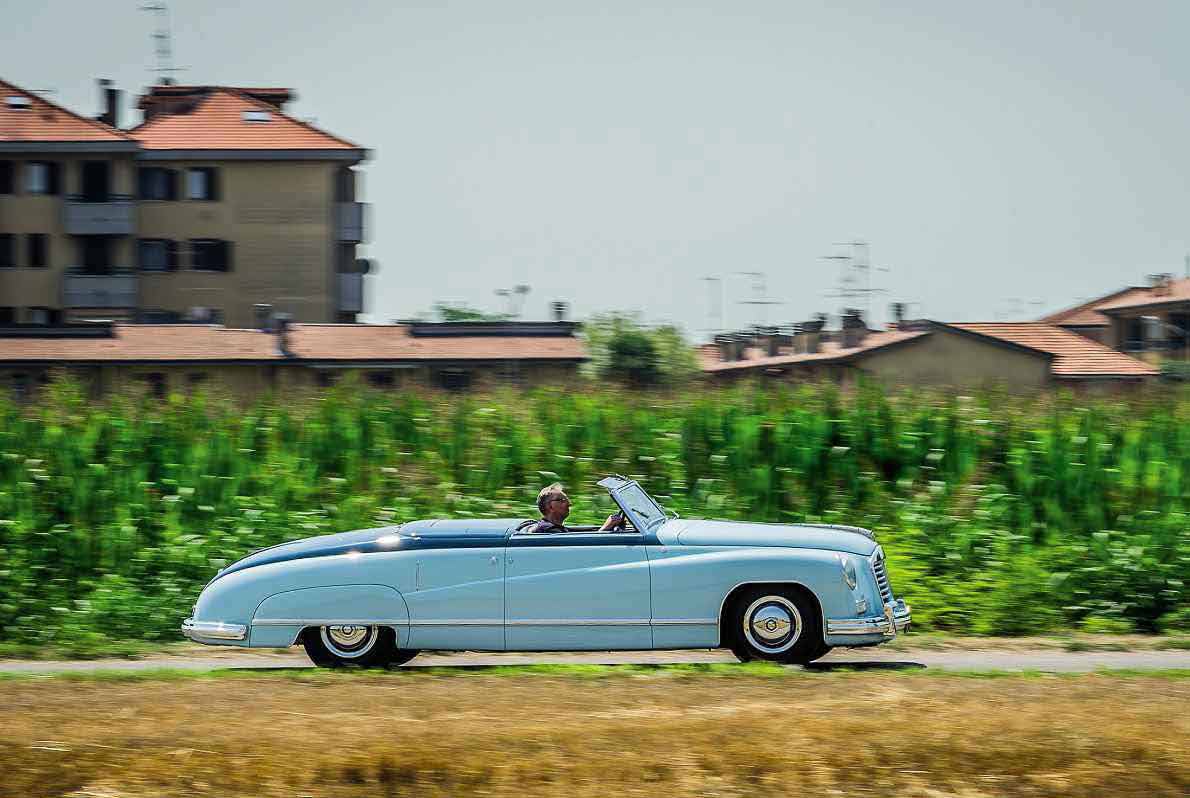
Gone but not forgotten Isotta Fraschini emerged from war-torn Italy with plans for a great future. Massimo Delbò drives the only two survivors Photography Massimiliano Serra Restoration images Federico Bajetti and Lopresto Collection Archive images Famiglia Bianchi Anderloni Archive.
ISOTTA FRASCHINI 8C Driving the only post-war survivors
Back in January 1900, when Cesare Isotta and the Fraschini brothers Oreste, Antonio and Vincenzo founded their new company, they never imagined they were creating what would become one of the most legendary marques in history. Società Milanese d’Automobili Isotta Fraschini made cars that were dreamed about by royalty, actors and industrialists all over the world.

There is a link between Isotta Fraschini, Alfa Romeo and, as Alfa Romeo’s racing chief, Enzo Ferrari, and that’s the city of Milan. Famous today for its business and the fashion, it has almost completely disappeared from the automotive map. Yet it was the first Italian city in the development of the car movement.
Darracq, Peugeot and Citroën had manufacturing plants in Milan, which was also home to Prinetti and Stucchi. Isotta Fraschini started life there as a Renault distributor and, as it quickly developed, it trained local technicians and mechanics. This helped local coachbuilders such as Touring (its founder, Felice Bianchi Anderloni, was the first Isotta Fraschini test driver and racer), Carrozzeria Cesare Sala, Castagna Milano and Zagato to flourish.
By the 1920s, Isotta Fraschini was considered one of the most advanced carmakers in the world, having been the first manufacturer to offer four-wheel brakes (1910) and a straight-eight engine (1919). It was hit by the Wall Street Crash of 1929, when the US market – Isotta Fraschini’s biggest audience – weakened and the company’s only production model, the ultra-luxurious Type 8, suddenly became too expensive. The decade leading up to World War Two saw the suffering company involved in a political fight with the Italian government (lobbied by Fiat’s owner, Giovanni Agnelli, who feared the competition) that prevented a manufacturing partnership with Henry Ford.
That government then forced Isotta Fraschini to produce trucks and naval engines for the war effort, promising more public procurement than would ever materialise. Even so, as hostilities ceased, the company tried to resurrect itself as a luxury car manufacturer with an innovative and advanced car: the 8C Monterosa. Its technical fathers were Fabio Luigi Rapi (at Isotta Fraschini since 1934) and Aurelio Baj, while its engine was designed by Aurelio Lampredi from the Scuderia Ferrari, to which he would return in 1948.

{module Autoads}

The first studies for the post-war car began in 1943. Because Milan had been badly bombed, Rapi was working in Saronno, about 30km north-west, in the former Caproni aircraft factory where he had spent the war years. There he sketched some of the car’s basic features: an extremely aerodynamic body, inspired by the revolutionary Tatra 77, paired with a rear-mounted V8 engine of 3.5 to 4.5 litres in capacity. Rapi’s ideas were soon approved by the management and development began. By 1945, in an impoverished Italy, the luxurious Isotta Fraschini 8C Monterosa took shape with a flat floor, a box-section chassis without transmission tunnel, a 3.0-litre V8 engine with many parts cast in Elektron alloy, and rubbersprung suspension.
This last item, manufactured by Pirelli subsidiary Sapa, was a real highlight, featuring self-damping rubber springs in place of normal coils and separate dampers to improve both handling and ride comfort. The gearbox was a brand new four-speeder, with an unusual shift pattern that put first and fourth on the upper branches of the ‘H’. The minimalist dashboard displayed only a speedometer, with four supplementary instruments hidden away under two small hatches. The 8C was very advanced for its era and many of its features would subsequently appear on other production cars 10 or 20 years later.
In his memoirs, Rapi recalled how, to celebrate the launch of the first prototype, all 29 members of the team jumped on the rolling chassis to have a picture taken, only for the rubber suspension to collapse after a few yards! This car – we don’t know if it bore chassis number one or two – had been bodied by Zagato while the company was still under German Army occupation, featured a rearmounted radiator, and was used for the initial road tests. Five more cars would follow in the years after, all equipped with on-board hydraulic jacks and a mechanism to raise the hinged rear fender skirt for access to the tyres. All were handbuilt, and each could be considered a prototype in its own right.
Prototype number three, shown at the start of the 1948 Mille Miglia and then driven to the Paris motor show to be used for test drives, was also bodied by Zagato, the main difference being its front-mounted radiator and the necessary inclusion of a larger front grille. Its engine survived, but the car is believed lost. It remains unclear whether the missing chassis, be it number one or two, was ever built or bodied.
Car number four was a Boneschi-bodied convertible with a hidden soft-top, a survivor that’s shown here. There are historic pictures which show two slightly different Boneschi cabriolets, one deep blue over ivory and another in two-tone pale blue, but evidence suggests that it is one and the same car, revised after a couple of years. Car number five was shown on the Isotta Fraschini stand during the 1947 Paris show, painted in green; it was later repainted black. This is the other survivor, now green again and also pictured here. It’s a two-door sedan bodied by Carrozzeria Touring which displays what had become the coachbuilder’s trademark fins flaring out from the wheelarches. Car number six was a fourdoor sedan by Touring, since lost; it was shown with the Boneschi at the 1949 Geneva show.
There was tragedy behind the five ‘production’ cars: the company was broke, its workers without salaries for six months, and the coachbuilders were never fully paid. To save money, the sales brochures were re-purposed press releases, showing sketches of 8C Monterosas equipped with different bodies, not all of which existed. In 1949 the company went into administration, to survive only as a brand as part of an industrial group managed by the Italian government. It built buses and trucks and then, as part of Fincantieri, manufactured of naval engines.
Little of Isotta Fraschini’s past remained at the Fincantieri-Saronno warehouses. However, an archive containing engineering drawings was saved, as were a pre-war Isotta Fraschini 8A and these two 8C Monterosas.
They would live a sedate life, kept only for static display and remaining in original condition until they were restored in the 1980s. After the work was carried out in Saronno, the two cars were stored and maintained for 10 years before being returned to Fincantieri and stored almost unused for the next 20 years.
‘I’ve been in contact with the Fincantieri management for a very long time,’ says Italian collector Corrado Lopresto. ‘I began my hunt in 2000 when dear friend and car historian Angelo Tito Anselmi sent me two pictures of the Monterosas with a note stating: you should own these cars. The pictures showed the two cars in a warehouse in Saronno, used by the local Isotta Fraschini division but owned, as were the cars, by the Finmeccanica group, now responsible for the IF brand and headquartered in Rome. Three years ago, the management showed some interest in the idea of selling the cars, stored in Rome, and the Isotta Fraschini car division archive from 1901 to 1947. They were no longer considered industrial assets but instead as something that needed space and care during a time of economic crisis.’
The archive was stored in wooden crates. ‘They were full of blueprints of every single detail of every single part ever built by the firm, both pre-war and post-war,’ says Lopresto. ‘It was absolutely amazing, and with many boxes still to be opened for the first time in decades, I keep finding beautiful surprises, information never known before and technical details thought lost forever.’
As for the cars… ‘Their condition was far from perfect but I knew since the first moment I saw them that I had to have them. I’ll never forget the emotion when I became the legal owner of the two 8C Monterosas and the sense of responsibility I felt in rescuing them. Thanks to the information we found in the archive, and the pictures taken in period, we started the process of a historically respectful restoration, knowing what we needed to bring them back to their original look and condition. Considering their age, the cars were sound, but the restoration work done in the 1980s covered many small details and wasn’t done with the correct historical approach.’
And so Lopresto sought out people with memories of the cars. For instance, Carlo Felice Bianchi Anderloni worked at Touring with his father after the war: ‘We had his interview, released in early 1980s, in which he described how, to speed up manufacturing when raw materials were not easy to find, they used the camel fabric, usually intended for coats, to upholster the interior.’
As for the restoration, as many original components as possible were kept and repaired or cleaned where necessary. ‘With parts that had already been restored we first analysed them to decide if they were original or not, and, when we were sure about their status, we replaced with a correct item or re-restored them to current standards,’ says Lopresto. The most important decision, and the most expensive, was to dismantle everything to be sure that every single component was correct. ‘I knew the suspension was broken, which was quite a challenge. The engine and transmission were not in bad shape, but rubbers and gaskets were badly aged and some parts were corroded or blocked. More challenging were the bodies and the interiors: these were prototypes, and they had developed during their working lives. We had to decide at which point to “freeze” the car and be respectful of that stage of evolution for every aspect of every compnent.’
I grew up in Milan, dreaming about the legend of Isotta Fraschini and hoping, one day, to see one of its cars in the metal. And then I joined a group of five people who have driven an 8C Monterosa. Two of them, in fact. Their restoration was completed only six hours ago, and the container in which they’ll be shipped to the USA is already waiting.
And so I climb aboard the Touring sedan and start its engine, which emits a deep, far-off burble. The pedals are suspended and there’s a linkage that allows the vertical section of the accelerator to tilt, which is perfect for double-declutching.
The clutch is light but the gearlever has that peculiar shift pattern. It transmits its actions via a 2.6m steel cable, which runs in a copper pipe full of oil to keep it greased. Moving off demands barely a touch of the gas pedal thanks to huge torque, accessible at very low engine speeds, after which acceleration picks up rapidly. The steering is light and perfectly geared, a highlight of the car.
Handling and ride differ between the sedan and the Boneschi convertible. Both are equipped with the futuristic rubber-sprung system, but the Boneschi has a small compressor pumping air into the chambers of the rubber wedges, making it more comfortable over bumps, while the Touring has a simpler version without air and provides a harder ride. At low speeds there’s a sense of understeer, though that rear-mounted engine will sooner or later make its presence felt. Thankfully the braking is well balanced front-to-rear.
In August 2017, together with Isotta Fraschini number one from 1901 (see panel, below), the two surviving Isotta Fraschini 8C Monterosas will be displayed at the Pebble Beach Concours – the first time they have been seen together since 1949. They will represent the dream of a 1940s visionary, a company that almost achieved the manufacture of a futuristic luxury car in the immediate post-war years.
Is there anything else Lopresto wants to do? ‘Car number two, by Zagato, was driven from Brescia to Paris in 1948, from the start of the Mille Miglia to the entrance of the Paris motor show, where the Touring car was on show. The Zagato is lost, but I’m tempted to drive the 8C Monterosa by Carrozzeria Touring back there.’
It would be a perfect way, 70 years on, to celebrate these two incredible cars, hidden away for so long yet never quite forgotten.
Tech and photos
TECHNICAL DATA FILE SPECIFICATIONS 1948 Isotta Fraschini 8C Monterosa
Engine Rear-mounted 2981cc V8, OHV, Weber 30 DCR2 carburettor
Max power 115bhp @ 4500rpm / DIN
Max torque 148lb ft @ 2500rpm / DIN
Transmission Four-speed manual, rear-wheel drive
Steering Worm and roller
Suspension Front: double wishbones, self-damping rubber wedges. Rear: swing axles, self-damping rubber wedges
Brakes Drums
Weight 1400kg
Performance Top speed 106mph
Clockwise from lower left Ownwr Corrado Lopresto lifts wing-spat for wheel access; stylish jukebox dash; Boneschi body is long and low; rear seat hidden dickey-style; spare slung under front bumper; V8 mounted in tail. Left and above To ensure the historically correct restoration of both 8Cs, Lopresto and his team could rely on archive drawings preserved since Isotta Fraschini foundered in 1949. Left, far left and below The Touring sedan starred on Isotta Fraschini’s stand at the 1948 Paris motor show and is now resplendent once more in the same shade of green – steering wheel included.
‘By the 1920s, Isotta Fraschini was one of the most advanced carmakers in the world’
‘As many original components as possible were kept and repaired or cleaned where necessary’
‘Moving off demands barely a touch of the gas pedal before acceleration picks up rapidly’
FIRST OF THE BREED
The earliest Isotta Fraschini now lives with the newest
It’s rare for the very first car built by a manufacturer in the early years of motoring to survive for so long. Rarer still that, after 116 years, chassis number one should live under the same roof as the last cars built by the same company. This Isotta Fraschini Type 1902, built in 1901, was the first built, yet it was never equipped with a body. It was used as a test bed for engine and transmission, and as a demonstrator for potential customers.
After three decades on show at the Isotta Fraschini headquarters in Milan, the car was given as a present by Italy’s fascist leader Benito Mussolini to Henry Ford, when he was supposed to begin manufacturing in Italy. But the Second World War saw Italy and USA pitched as enemies, and the Isotta was relocated from the Dearborn Ford Museum to an obscure warehouse, where it remained for the following 70 years.
It was sold in the USA, and soon afterwards entered the Lopresto Collection. It has never been restored; the mechanicals just needed refreshing for the 2015 London to Brighton Run, where it won the trophy for most historically important car. In order to drive the car, Lopresto simply added a Plexiglas floor and a pair of bucket seats, both easily detachable so it could be returned to its original state.





